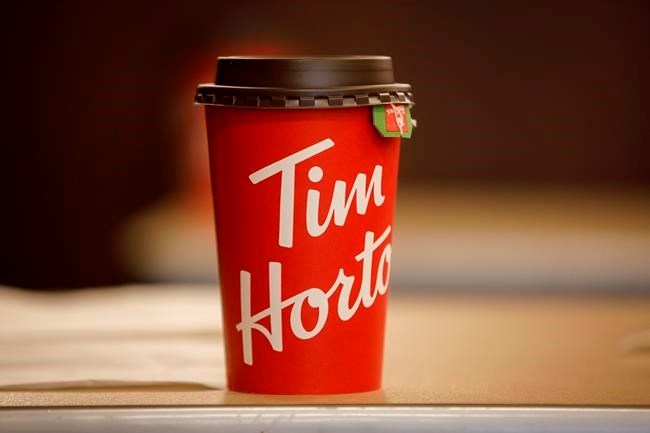TORONTO — The pandemic continued eating into profits for Restaurant Brands International Inc. in the third-quarter, as disruption to daily rituals like going to work and taking kids to hockey curbed sales.
The parent company of Tim Hortons, Burger King and Popeyes, which keeps its books in U.S. dollars, said Tuesday its net income for the quarter was US$223 million or 47 cents per diluted share, down from US$351 million or 75 cents per diluted share a year earlier.
Revenue totalled US$1.34 billion for the quarter ended Sept. 30, down from US$1.46 billion in the same period a year ago.
The company said the year-over-year decrease in sales was primarily driven by a decline at Tim Hortons and Burger King and a decrease in supply chain sales, partially offset by an increase in sales at Popeyes.
Restaurant Brands chief executive Jose Cil said while the restaurants have made "steady progress" reopening, the company's performance also reflected "certain more challenging impacts of the pandemic on consumer behaviour."
"Routines remain on hold for a significant percentage of people as many offices, schools and other establishments remain closed," he said during a conference call with analysts.
"Millions of people are still working from home, and the recent spike in cases in different parts of the world has caused some localities to reinstate certain restrictions, including the closure of dining rooms in some cases."
The change in consumption patterns has deeply impacted coffee and doughnut chain Tim Hortons.
"Tim Hortons is uniquely interwoven into everyday Canadian life," RBI chief corporate officer Duncan Fulton said in an interview.
"We're tied to your pattern of going back and forth to work, we're tied to your pattern of taking the kids to hockey or soccer," he said. "If those patterns get disrupted, it obviously has an impact on our business."
Still, RBI remains focused on the "long-term positioning" of its three major brands in a bid to return to growth, Cil said.
He said the company is proceeding as planned with the so-called portfolio optimization noted in the previous quarter, which will replace older underperforming restaurants with new locations.
"The stores we're closing generate revenue 30 per cent lower than the average in their regions," he said. "We expect the closures will have a relatively small near-term impact on our store count, and an even smaller impact on system-wide sales."
Restaurant Brands did not disclose the number of closures planned this year. Instead, it said its net restaurant growth – which takes into account restaurant closures and openings across its three brands – will be flat this year.
Meanwhile, RBI is rolling out digital menu boards at its restaurant drive-thrus, with Tim Hortons leading the way.
The fast-food chain currently has 800 digital menus installed, with all 2,700 Canadian locations expected to have the new menus by the end of 2021.
Tim Hortons is now testing options to scan a loyalty card or tap-to-pay directly from the drive-thru digital menu.
"It's about modernizing the drive-thru and integrating loyalty rewards to make for more personalized, faster service," Fulton said.
The new menus give restaurants the ability to engage in predictive marketing sales based on things like the weather or regional best sellers, or more personalized marketing if customers choose to scan a loyalty card.
"If you're in Halifax and it's cold and foggy, we have the ability to promote a hot beverage versus if it's a hot and sunny day we could promote a cold beverage," he said.
"If you scan a loyalty card, we understand your previous purchase habits and can make more personalized recommendations."
On an adjusted basis, RBI said it earned US$320 million or 68 cents per diluted share, down from an adjusted profit of US$337 million or 72 cents per diluted share in the same quarter last year.
Analysts on average had expected a profit of 63 cents per share for the quarter, according to financial data firm Refinitiv.
This report by The Canadian Press was first published Oct. 27, 2020.
Companies in this story: (TSX:QSR, TSX:QSP.UN)
Brett Bundale, The Canadian Press

